
Before the first Commission meeting of 2024, marking my third term as a Seattle Port Commissioner, I’d like to summarize some of the highlights of the past year that were of particular importance to me. The thread that continues to run through my tenure on the Commission is my commitment to strive to balance the needs of commerce, communities, and the climate.
Doing well to do good
The Port of Seattle generates more than 121,000 jobs in the region, and I continue to work to ensure this economic engine runs on clean fuel. The Port of Seattle has the most diverse lines of business of any port in the country — with both an airport and marine cargo terminals as well as serving as homeport for commercial fishing and cruise operations in Alaska. The majority of our maritime cargo is managed through the Northwest Seaport Alliance (NWSA), a joint operating agreement with the Port of Tacoma.
Seattle Tacoma International Airport (SEA) is amongst the nation’s largest and fastest growing airports. The Port also manages four recreational marinas, 65 acres of public parks, and commercial real estate holdings. In addition, the Port conducts a variety of workforce, economic development, community, and environmental programs which require that it does well in order to do good.
While there is need for restoration efforts to address historic damages to the environment, the greatest challenge for me is to identify and incentivize new ways of doing business that can reduce our own impact and that of our tenants on the environment, climate, and near-port communities.
The intensifying effects of climate change make investing in low-carbon infrastructure an imperative which I have long believed will become a competitive advantage as consumers call for industry action. However, port-related industries rely on ships, planes, trucks, and trains, which are amongst the hardest to decarbonize and will require major public investments and incentives to occur. Fortunately, the state and federal governments are making unprecedented levels of grant funding available, which the Port and the NWSA continue to successfully pursue. My third term will be dedicated to securing as much state and federal public investment as possible to accelerate the Port’s green fuels and energy transition efforts.
At the same time, post COVID-19 pent-up demand for travel has resulted in record numbers of passengers on airplanes and cruise ships. Reducing impacts while growing is the greatest challenge.
Strong demand for travel and trade demonstrates the enduring need for the Port’s services. SEA handled record-breaking levels of travel this summer, marking new milestones for the most daily passengers in the airport’s history. The Port’s cruise terminals served the highest number of passengers for the second year in a row, and maritime industrial occupancies remain at all-time highs.
The Port’s budget is based primarily on revenues from leases charged to tenants at the airport, seaport, and commercial real estate with property taxes generating $83 million of the Port’s $954 million operating budget (8.7%). We will invest $920 million per year over the next five years on construction projects at the airport in an effort to meet regional demand. The 2023 Budget in Brief does a great job of summarizing the budget; however, below is a snapshot of the 2023 budget, through the third quarter:
2023 Aviation
- Operating Revenues: $801.1 million
- Operating Expenses: $460.5 million
- 2023 Capital Spending: $663.9 million
- Five-Year Capital Spending: $4.6 billion
2023 Maritime
- Operating Revenues: $75.9 million
- Operating Expenses: $66.1 million
- 2023 Capital Spending: $40.8 million
- Five-Year Capital Spending: $352.6 million
2023 Economic Development
- Operating Revenues: $22.2 million
- Operating Expenses: $30.1 million
- 2023 Capital Spending: $6.7 million
- Five-Year Capital Spending: $169.7 million
Major accomplishments in 2023
Terminal 5 construction and electrification of operations
The NWSA project Terminal 5 Improvements is the most significant new development on the working waterfront. After extensive environmental review, permitting, and coordination with the Muckleshoot and Suquamish Tribes, the Terminal 5 modernization program broke ground in 2019. In January of 2022 operations on the north berth began with three cranes capable of handling containers on the largest ships. It includes 185 acres of cargo capacity and the ability to move containers directly from ships to trains — reducing the congestion and pollution associated with drayage trucks.
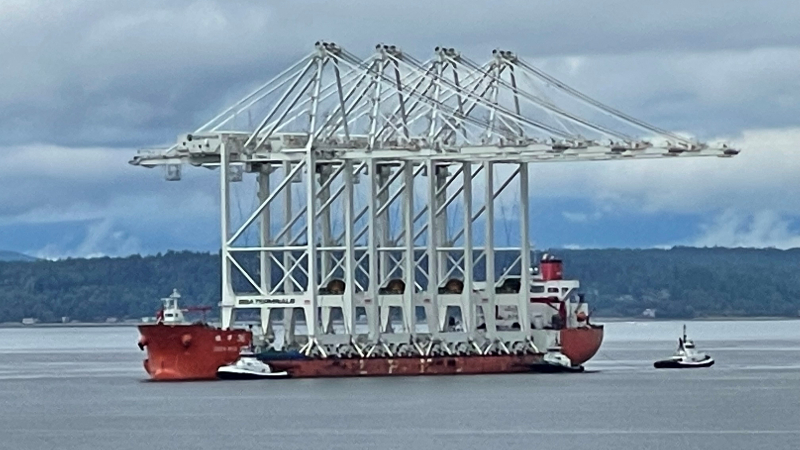
Phase two of the Terminal 5 modernization is well underway with two more of the largest container cranes arriving at the Port on November 17. Operations in the south berth are expected to begin in 2024.
The Northwest Ports Clean Air Strategy calls for installation of shore power infrastructure on all international container terminals by 2030 thereby enabling ships to turn off their engines at berth. April 10, 2023 marked a significant environmental milestone when the container vessel MSC Brunella called on Terminal 5, making it the first international cargo terminal in Seattle or Tacoma to use shore power. If the number of ships that call on Terminal 18 utilized shore power at Terminal 5, it would significantly reduce air, water, and noise pollution, with an estimated reduction of 6,000 tons of greenhouse gases (GHGs) and 1.4 tons of diesel particulate matter a year. I want to thank SSA Terminals, Mediterranean Shipping Company (MSC), Pacific Crane Maintenance Company (PCMC), the International Longshore Workers Union (ILWU) Local 19 working alongside the NWSA and Port of Seattle staff to ensure the success of this significant accomplishment. I’m also thankful for the Washington State Legislature for appropriating $4.4 million towards the project.
Due in part to the leadership of Senators Murray and Cantwell, the federal government has also made significant amounts of funding available for greening port infrastructure. The Port and NWSA will be actively seeking to secure some of the $3 billion of funding from the Infrastructure Investment and Jobs Act which becomes available through the EPA in 2024.
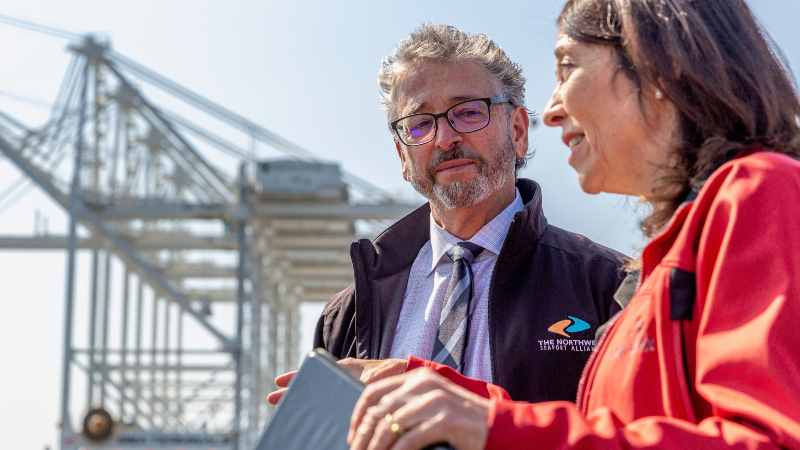
The Port of Seattle is also working to make shore power available at all our cruise terminals. Bell Harbor will be shore power ready by 2025 and all cruise ships that are able to plug in will be required to plug in. More than half of the cargo vessels and cruise ships that currently call in Seattle and Tacoma are shore power ready.
Drayage trucks
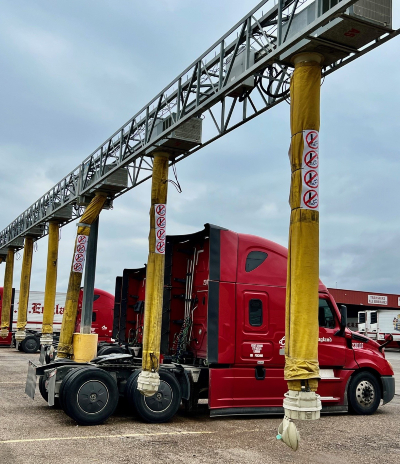 Drayage trucks move goods from marine terminals to warehouses and stores when rail is not an option. Trucks account for 45% of the GHG emissions and 20% of the diesel particulates in the Seattle harbor. Near-port communities are disproportionately exposed to these emissions, making their reduction a priority. Trucks older than 2007 are prohibited from entering international container terminals and additional parking has reduced their presence in communities. There are significant investments being made at the state and federal level to foster the transition to electric trucks. The challenge, however, is daunting in that a new electric truck costs in excess of $400,000 whereas a used drayage truck can be purchased for $50,000. While pilot projects are getting underway with a limited number of trucks, there are over 3,500 drayage trucks serving the terminals in Seattle and Tacoma, which will also need the space and charging infrastructure to be operational.
Drayage trucks move goods from marine terminals to warehouses and stores when rail is not an option. Trucks account for 45% of the GHG emissions and 20% of the diesel particulates in the Seattle harbor. Near-port communities are disproportionately exposed to these emissions, making their reduction a priority. Trucks older than 2007 are prohibited from entering international container terminals and additional parking has reduced their presence in communities. There are significant investments being made at the state and federal level to foster the transition to electric trucks. The challenge, however, is daunting in that a new electric truck costs in excess of $400,000 whereas a used drayage truck can be purchased for $50,000. While pilot projects are getting underway with a limited number of trucks, there are over 3,500 drayage trucks serving the terminals in Seattle and Tacoma, which will also need the space and charging infrastructure to be operational.
While I was in Texas for a conference, I visited IdleAir, a company that provides heat and air conditioning as well as power to trucks, which enables drivers to turn off their engines when parked. In 2024 I look forward to further exploring technology such as IdleAir and truck parking away from neighborhoods that could implement this technology in the interim.
Passage of historic City of Seattle industrial lands policy
The Commission spends significant time working with fellow elected officials to influence public policies pertinent to the Port and our constituents. The preservation of industrially zoned land is foundational to our economic activities, and we continue to resist pressure to rezone waterfront-adjacent properties.
I testified before the Seattle City Council twice in 2023, underscoring that industrial lands comprise 12% of the City of Seattle’s land area but deliver 30% of its tax revenue and support thousands of jobs.
On July 18 the City Council passed Mayor Harrell’s industrial lands package establishing durable protections for maritime and industrial areas across Seattle. The City Council and Mayor not only protected living wage jobs they protected neighborhoods from congestion and emissions from heavy industry. It is especially rewarding when we can find mutually beneficial ways for commerce and communities to coexist.
Commerce and cyclists coexisting on Alaskan Way
For the safety, sustainability, and economy of our city, we need to find ways for cyclists and commerce to safely coexist. Finding mutual solutions is a matter of thoughtful discussions and clever ideas, which I’m proud to say are underway.

The Cascade Bicycle Club, Seattle Neighborhood Greenways, cruise lines, labor unions, business owners, and residents along Alaskan Way have been carefully considering each other’s needs as Seattle Department of Transportation designs a protected bike path along the north end of Alaskan Way between piers 62 and 70. We believe we have found a solution by adding a second path on the east side of the street so that cyclists have an easy detour around the crowds during cruise operations. There will be a protected bike path along the west side of the street when cruise ships are not present.
Throughout the discussions over how to deconflict traffic around the Bell Harbor cruise terminal I’ve suggested that the unused former George Benson trolley tracks on Alaskan Way must be utilized to support pedestrians and bicyclists. While this solution was dismissed as too expensive, recent developments have supported the idea of thinking big, removing the tracks, and replacing them with a protected path connecting Alaskan Way to Myrtle Edwards Park, Centennial Park, and the improved path through Terminal 91.
Enhancing waterfront trail via Elliott Bay Connections
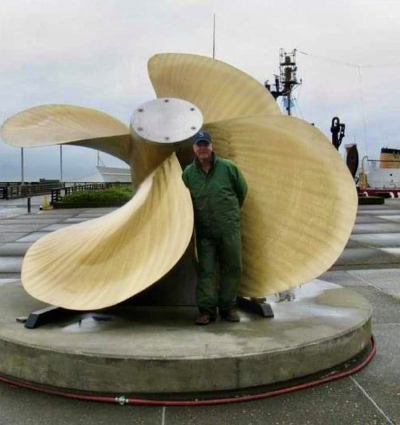
The Port, the City of Seattle, and a handful of civic-minded philanthropists recently announced that they’ll collaborate with the Downtown Seattle Association to build a recreational bike trail where the old streetcar tracks are on Alaskan Way between piers 62 and 70 (Virginia Street to Broad Street) as I was previously suggesting. The Elliott Bay Connections project will also vastly improve the bike path through Myrtle Edwards Park and Centennial Park and affords an opportunity to collaborate on the interpretive signage the port is contributing to as part of the public’s reengagement with the waterfront. The goal is to have these improvements, as well as several other park amenities completed before thousands of tourists visit for the FIFA World Cup matches played here in 2026.
I’d like to thank Melinda French Gates, MacKenzie Scott, the Diller-Von Furstenberg Family Foundation, and the Expedia Group for their vision and generous contributions that are making this project come to life.
The Elliott Bay Connections will also afford an opportunity to collaborate on the interpretive signage the Port is contributing to as part of the generational transformation that’s occurring along the central waterfront to the north. I’m particularly excited to find locations to install the four propellers the Port secured from Washington State Ferries, which were going to be sold for their salvage value. I sought their acquisition thinking they would make the perfect selfie site for the public to be drawn to where they would also learn about the Port and the maritime environment.
Improving cyclist safety through Interbay
The Port’s Terminal 91 Trail is part of the Elliott Bay Trail, the main waterfront route between Interbay and Downtown. It runs safely around the Port of Seattle’s Terminal 91 — homeport to the Alaska Fishing Fleet, the Smith Cove Cruise Terminal, and the Pier 86 grain elevators.
Improving this trail has been a priority of mine for years, and next year the Port will replace the pedestrian/bicycle bridge with a ground-level pathway and widen the trail and upgrade the existing rail crossing.
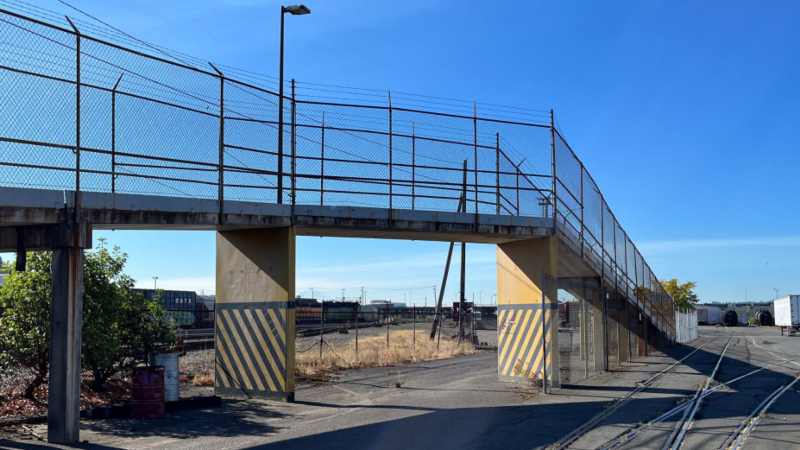
Big steps forward in Seattle Aquarium – Port collaboration
I led the effort for the Port of Seattle to invest in the Ocean Pavilion as we share many values with the Seattle Aquarium, including the need to foster a “one ocean” ethic, especially across the Pacific. The pavilion will illustrate such efforts and the opportunities to maintain a sustainable relationship with the sea. From canoes to containerships, this region’s natural wealth continues to be a gateway for communities and commerce.
As part of the Port’s contribution, I am particularly proud of my work with the aquarium’s exhibit designers to come up with the concept and directly contribute to the design of the “Port Sound Walk.” The exhibit will enable the public to enjoy an immersive auditory experience and understand Port efforts to reduce underwater ship noise that can interfere acoustically sensitive marine life such as Orca whales. Visitors will also learn about Port-related environmental jobs.
In keeping with the theme portrayed throughout the aquarium, the Port is committed to supporting efforts to advance our coexistence with the marine environment.
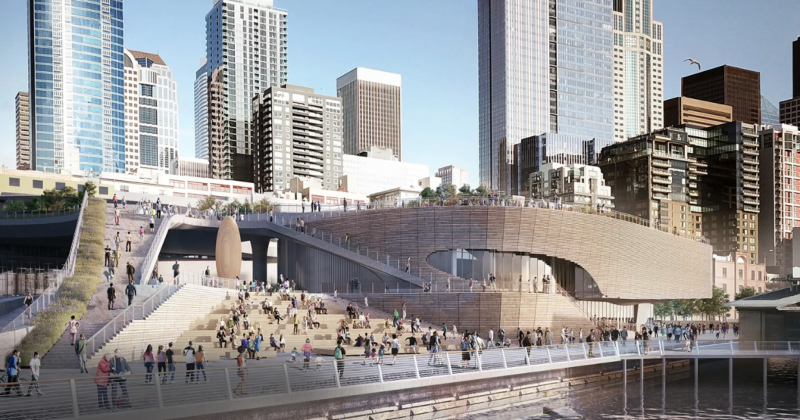
Aquarium collaborate to restore kelp forests in Elliott Bay
Kelp forests are a foundation of the Salish Sea ecosystem, providing food, habitat, and refuge for numerous species of fish, birds, and marine mammals. They also absorb carbon from the atmosphere and may reduce the impacts of ocean acidification.

State Legislature passed a bill, with my input and support, directing the Department of Natural Resources to create a statewide Kelp Forest and Eelgrass Meadow Health and Conservation Plan to conserve and restore at least 10,000 acres of kelp forest and eelgrass meadow habitat by 2040.
The Port Commission approved my budget priority in 2023 and 2024 to support research led by the Seattle Aquarium to study and map the presence of kelp forests along the urban waterfront of Elliott Bay as well as the East and West Waterways of the Seattle harbor. This effort will contribute to the state’s conservation plan and also inform our habitat restoration efforts.
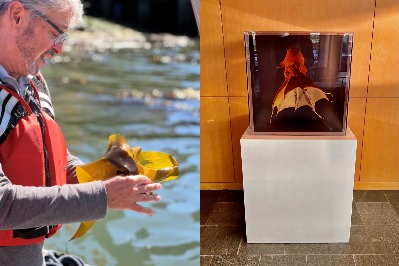
In another effort to elevate ocean awareness I hosted an Ocean Research Seminar with the Schmidt Ocean Institute attracting a an audience of maritime, marine science, and art communities in hopes to inspire future generations to look to the sea for marine and maritime career opportunities. We learned from Schmidt and University of Washington marine scientists about new discoveries, including seemingly alien lifeforms that live near volcanic vents along the mid-Atlantic ridge. These discoveries served as inspiration for creations made by artists on board, some of which were put on display at the Port for several months.
Reducing the impacts of ships above and below the water with Green Corridors
A green corridor is a shipping route where zero greenhouse gas (GHG) solutions are considered, demonstrated, and supported. Green corridors — through collaboration across sectors — establish the technological, economic, and regulatory feasibility needed to accelerate implementation of low and ultimately zero GHG emission vessels.
In 2021, 24 countries, including the United States and Canada, signed the Clydebank Declaration and in doing so, committed to support the establishment of at least six green corridors by 2025 while aiming to scale up activity in future years.
On May 17, 2022, the Port of Seattle, City and Borough of Juneau, Vancouver Fraser Port Authority, Carnival Corporation, Norwegian Cruise Line Holdings, Royal Caribbean Group, Cruise Lines International Association, the Global Maritime Forum, Blue Sky Maritime Coalition, and Washington Maritime Blue launched a collaborative effort to explore the feasibility of a maritime green corridor aimed at accelerating the deployment of zero GHG emission cruise ships and operations between Alaska, British Columbia, and Washington. The communities of Sitka, Skagway, and Haines in Alaska and the Greater Victoria Harbor Authority have also joined the partnership.
The First Movers are developing a scope of work for a green corridor feasibility study focused on the Alaska cruise market. Read a draft Scoping Proposal to learn more about the topics and study approach under consideration. The scope remains under development and the topics within this draft proposal are subject to change.
A similar effort is underway between the Republic of Korea and the Northwest Seaport Alliance.
International efforts to reduce greenhouse gas emissions and noise from ships
Maritime shipping accounts for 3% of global greenhouse gas (GHG) emissions and is the main contributor to underwater noise in the ocean. The underwater noise of a cargo vessel at top speed is louder than a jet engine at takeoff. And since sound travels four times faster in water than air, the noise from one ship — let alone many — can have far-reaching impacts.
However, concerns exist that efforts to reduce underwater noise may reduce ships’ efficiency, thereby increasing their GHG emissions. A report was published following the International Maritime Organization (IMO) Expert Workshop on the relationship between energy efficiency and underwater radiated noise.
On September 19 and 20, I had the honor of serving on the International Association of Ports and Harbors delegation and joined world experts on underwater noise and energy efficiency at the IMO in London. This was a great opportunity to apply my expertise in marine mammals and vessel traffic to the operational and technical measures that reduce ship-induced GHG emissions and reduce underwater radiated noise concurrently.
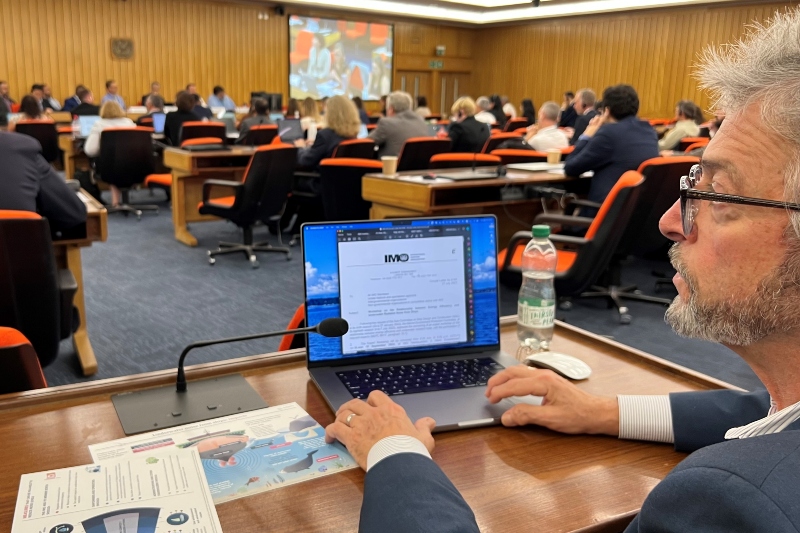
I’m proud to have been able to contribute to the report’s findings including the following takeaways:
- Green corridors are a prime opportunity to integrate ship quieting technologies with domestic and international energy efficiency and GHG reduction commitments and policies to improve climate and ocean health.
- More incentive schemes and other mechanisms are needed to de-risk and encourage early adoption of integrated GHG and underwater noise reduction technologies and measures for ships.
- Shippers, charterers, ship managers, and port authorities (just in time) can have significant influence over operation of the ship. The report found these issues should be taken into consideration as part of voyage planning and while underway.
Reducing vessel noise locally
In 2021 a new effort was initiated locally to reduce underwater ship noise, called Quiet Sound. This project, involving a broad range of stakeholders, was recommended in the final report of Governor Inslee’s Southern Resident Orca Task Force that was published in November 2019. I served on the Vessel Traffic Working Group and led the effort to draw from the successful experience of the Vancouver Fraser Port Authority’s Enhancing Cetacean Habitat and Observation (ECHO) program. Port of Anacortes Commissioner Kathy Pittis, and I assured its inclusion in the recommendations, which were endorsed by the Washington Public Ports Association, the Ports of Seattle and Tacoma, and the NWSA.
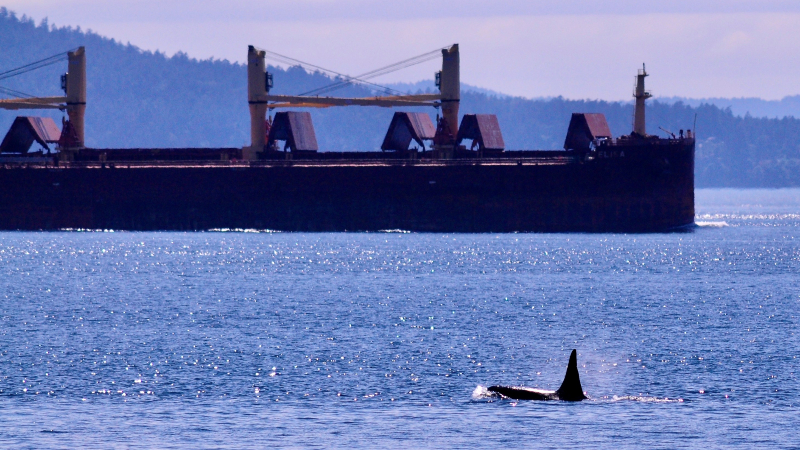
The Quiet Sound study area extends approximately along the length of the west side of Whidbey Island in an area 22 nautical miles long through Admiralty Inlet and north Puget Sound. Its primary goal is to have ships slow down in this region to reduce noise that would interfere with the remaining 75 Southern Resident killer whales’ ability to catch salmon — their primary prey. This project is timed to begin when the whales are in the region coinciding with the fall runs of chum and chinook salmon.
Container vessels, vehicle carriers, and cruise ships are asked to voluntarily slow to 14.5 knots, while tankers and bulkers are asked to slow to 11 knots. The Puget Sound Pilots have been very diligent in complying with the voluntary guidelines, and the number of whale sightings being reported to the program has increased significantly now that they are accessing information from the region’s long-established sighting program — Orca Network.
Sustainable Evaluation Framework
Perhaps one of my most enduring contributions to Port policy was to initiate the development of the Sustainable Evaluation Framework. Beginning with introduction of Motion 2017-14 in 2017 and Resolution No. 3768 in 2019, the framework challenges port staff to present the commission with innovative options to enhance the sustainability of major construction projects well beyond code requirements.
The criteria that are used when major construction projects are at 30% design are to: 1) Reduce GHG emissions 2) Protect health and the environment 3) Increase resilience 4) Support local economic development 5) Advance innovation 6) Leverage and develop partnerships, and 6) Advance equity.
In 2023 two major projects were screened through the Sustainable Evaluation Framework. At the airport, the C Concourse Expansion aims to elevate SEA, literally, by adding four additional floors above the existing building and raise the bar on the airport experience and sustainability.
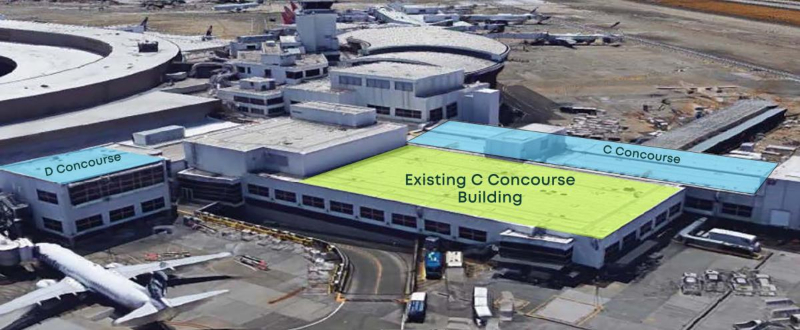
The sustainable features of this project, including solar arrays and all-electric heating and cooking equipment, will set the precedent for future capital projects at the Port. Learn more about this exciting project!
At Fishermen’s Terminal the Port has raised the bar even higher. As part of the design to transform the Fisheries Supply building into a Maritime Innovation Center (MInC ), the Port is planning to make its oldest structure able to meet the Living Building Challenge. As a Living Building, the MInC will have its own utility, generate its own energy, capture its own water, and process its own waste. Groundbreaking will begin in 2024.
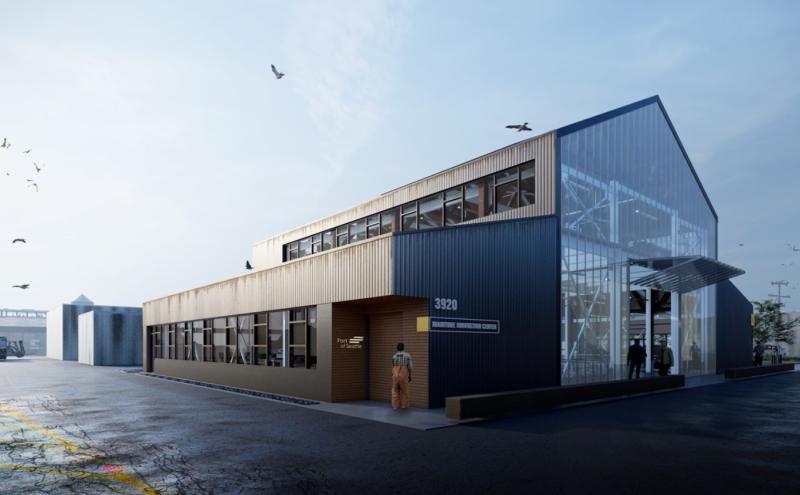
Sustainable aviation fuels
Sustainable aviation fuels (SAF) can reduce the carbon intensity of the existing airline fleet by 80%. The European Union has already enacted SAF use requirements.
SAF can be blended with fossil fuels, but there are two major issues impeding wide adoption by the airlines — availability of feedstocks and price. The Port has been working to address both these challenges through passage of legislation such as the federal “blender tax credit” as well as the state’s Low Carbon Fuel Standard and Climate Commitment Act.
In addition, we’ve been working with King County to pursue locally available feed stocks and with the Department of Defense to increase production which will work to bring down price.
Municipal Solid Waste — King County
Following the completion of the report by Washington State University in 2022 which identified municipal solid waste (MSW) as the most promising feedstock for producing SAF regionally, I secured matching funds from King County to explore the feasibility of utilizing some of the MSW that would otherwise be disposed of at their Cedar Hills landfill.
The jointly funded MSW report was completed at the end of 2023. It found that while MSW is a viable feedstock for producing SAF regionally, it would only be economically viable if King County’s MSW was consolidated with the much larger landfills in Washington and Oregon bordering the Columbia River.
One opportunity that still needs further evaluation is capturing the methane that is escaping from King County’s and other landfills for use as a feedstock. This idea is being explored by a commercial operator, SkyNRG.
Department of Defense pilot project
In 2023 the Port worked closely with U.S. Congressman Adam Smith, who included Sec. 324 in the National Defense Authorization Act (NDAA). The legislation calls for the Department of Defense (DOD) to identify two military bases that are adjacent to a commercial airport which are interested in pursuing the use of SAF. We believe that SEA being close to Joint Base Lewis McCord (JBLM) and connected to the Par Pacific refinery in Tacoma makes our region ideally suited for the pilot.
The DOD has begun preparations to conduct the pilot, which would identify any logistical challenges with respect to the use of SAF by the department, promote understanding of the technical and performance characteristics of SAF used in a military setting, and engage nearby commercial airports regarding the use of SAF, as well as providing recommendations on installations that meet the criteria and estimating the total cost of the pilot, to include SAF procurement.
The DOD intends to use the results of the study to inform its selection of the installations that will be used in the pilot, as well as a formal request for funding the pilot in their planning, programming, budgeting, and execution process. We expect the study to be completed in 2024.
Community support
As important it is for the Port to continue to obtain permits to construct and conduct industrial activities in a burgeoning city, it must also retain the social license of the community to pursue these efforts. It’s not just the right thing to do, it’s essential to the Port’s ability to support the economy as it has done since the founding of the city. As our economy continues to diversify, developers look to the Port’s major land holdings for alternative uses and the public is largely unaware of the Port’s positive contributions, such as those being highlighted here.
The Port has been increasing its investments in fence-line communities through programs such as the South King County Community Impact Fund and the Duwamish Valley Community Benefits Commitment agreement.
While I was directly involved with the establishment of these programs and remain engaged with them, I have also been focused on taking a variety of initiatives to deepen our relationships with the Muckleshoot and Suquamish Tribes.
Tribal relations
The Port and NWSA conducts marine operations in waters that overlap with the Tribes’ Treaty-protected Usual and Accustomed fishing areas. Traditionally, our relations with the Tribes have been primary transactional — based on mitigating our impacts to their fishing gear, habitat, and opportunities to fish in exchange for their review and concurrence on permits we continue to seek for in-water work.
My goal throughout my tenure has been to expand this relationship by identifying a broader range of interests we share and that we can pursue together, thereby building a deeper, more resilient relationship that will persist well beyond the term of an elected official or Executive Director.
One of the more significant achievements the Port made this year was to sign a Memorandum of Agreement (MOA) with the Muckleshoot Indian Tribal Government. The MOA will expand our government-to-government relationship, including regular and structured communication between the leadership of both entities. With this MOA, the Port and Muckleshoot will have a greater ability to collaborate on mutually agreed interests such as economic development, intergovernmental advocacy, education, and job training, fish and wildlife habitat restoration, and environmental stewardship.
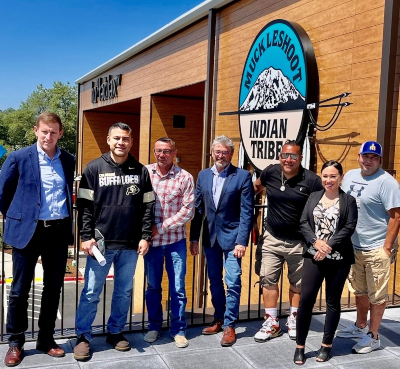 By signing the MOA, the Muckleshoot Tribal Government and the Port of Seattle have taken a major step from coexistence to collaboration. Our special relationship with the Tribes is critical to achieving our mission as a public agency.
By signing the MOA, the Muckleshoot Tribal Government and the Port of Seattle have taken a major step from coexistence to collaboration. Our special relationship with the Tribes is critical to achieving our mission as a public agency.
The MOA calls for the Port and Tribe to develop a work plan that identifies projects and initiatives intended to make progress toward sustainable coexistence on the land and waters of the region. We are also developing an MOA with the Suquamish Tribe, which should be completed in early 2024.
The Port just took a major step toward increasing our collaboration with tribal governments by hiring Roxanne Murphy as a new Senior Manager of Tribal Relations. Roxanne is a member of the Nooksack Tribe and has a wide array of experience that will be invaluable to the Port, including being the first tribal member to serve on the Bellingham City Council. She will oversee the work plan and further shared objectives developed through the MOA.
Sustainable ecotourism
Senator Gaylord Nelson, who co-founded Earth Day with Denis Hayes, once said, “The economy is a wholly owned subsidiary of the environment, not the other way around.” That’s my philosophy, too, and it pertains directly to tourism, which is a major part of the Port’s economic development portfolio given that we own and manage SEA and three cruise terminals on Elliott Bay.
This past year I continued to worked diligently on tourism issues, looking into ways to minimize its negative impacts so that communities can benefit economically while working to protect and restore the natural and cultural riches that so many visitors come here to enjoy.
United States Travel and Tourism Advisory Board
I was appointed to the U.S. Travel and Tourism Advisory Board (TTAB) back in January. This prestigious group of travel industry leaders, representing a broad range of stakeholders, makes annual recommendations to the U.S. Department of Commerce’s Secretary, Gina Raimondo, about how to rebuild this industry that was heavily impacted by COVID-19.
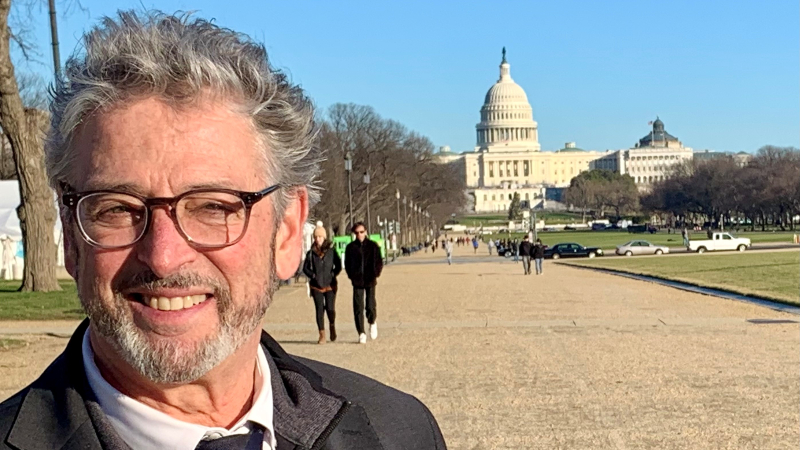
There were five subcommittees. The Sustainability Subcommittee, on which I served, made seven recommendations to the Secretary to guide the recovery efforts. The two most pertinent recommendations to my work on ecotourism include:
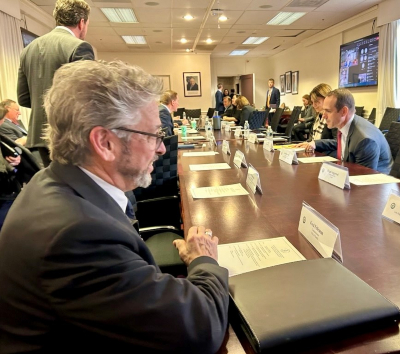 We recommend that the Department of Commerce adopt the GSTC (Global Sustainable Tourism Council) as the national standard for tourism sustainability measurement; (From Recommendation #1)
We recommend that the Department of Commerce adopt the GSTC (Global Sustainable Tourism Council) as the national standard for tourism sustainability measurement; (From Recommendation #1)- Recognizing that federal lands and waters fall under the jurisdiction of multiple departments, we recommend that the Secretary advocate for a whole-of-government approach to provide the funding and other resources needed to address the significant deferred maintenance and improved infrastructure requirements of these vital natural resources. (From Recommendation #7)
Snoqualmie pilot project
I’m working with a variety of stakeholders in the Snoqualmie Falls region to see if it could serve as a pilot project to achieve international recognition as a sustainable destination through the GSTC (see above).
The Mountains to Sound Greenway Trust who, since 1990, has been central to the sustainable management of this Scenic Byway which is also a National Heritage Area, has been an invaluable partner in helping to evaluate the viability of the effort.
The increased demand for outdoor opportunities associated with COVID-19 provided a glimpse into the future as to how overrun our natural areas can become if concerted efforts are not made to improve the infrastructure and expectations of visitors both before and upon their arrival. This cautionary tale was an impetus for the Snoqualmie Tribe to initiate efforts to protect the highly trafficked region.
Prior to COVID-19 the Snoqualmie Falls was already the second most-visited site in Washington state with 1.5 million visitors annually. It’s second only to Mount Rainier, which receives about two million visitors each year. Those visitors bring important economic prosperity to our region. My interest is that they visit respectfully and that the economic benefits should be greatest locally.
Pacific Northwest Economic Region
Seattle will welcome the FIFA World Cup in 2026! Several matches will be played in the region. Experts predict we’ll host anywhere from 400,000 to 750,000 people, and that the majority of them will be from another country. The best way to successfully host so many visitors is with a regional approach. This past year I worked closely with the Pacific Northwest Economic Region (PNWER), on how to collaborate with British Columbia, which will also host matches. This year PNWER established a Regional Tourism Council to help prepare for the event, which I plan to contribute to.
I also sit on the Visit Seattle Advisory Board. Visit Seattle successfully lobbied the Seattle City Council to double the $2 per night Seattle Tourism Improvement Area fee to $4. This, combined with the new Seattle Convention Center and the forthcoming new downtown waterfront, will greatly help us capture multiple benefits from the World Cup. These investments will continue to contribute to the revitalization of Downtown, which has still not recovered from the impacts of COVID-19.
Leaving things better than how we found them
The Port has made great strides to restore important fish and wildlife habitats on industrial properties that had been greatly impacted by activities that occurred many years ago.
The Duwamish River People's Park is located on the ancestral site of the Indigenous water-related place, ł(ə)gʷalb, referring to an abandoned or old river channel. The southern portion of the park is on an old riverbank with the name of xʷapičəd (wha-PEE-chud).
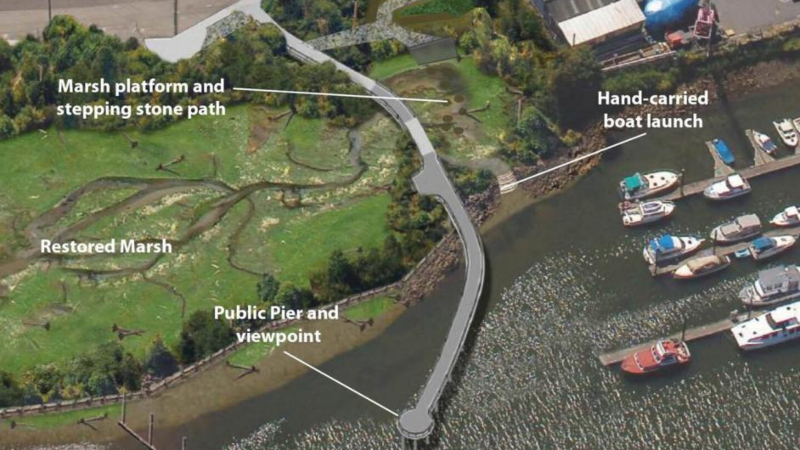
In 2020, the Port broke ground on the construction of the park, which now offers 14 acres of critical fish and wildlife habitat and public shoreline access. This large-scale restoration project supports recovery of the endangered Southern Resident orca population by significantly increasing habitat critical to abundance and health of Chinook salmon. It also provides public access to this beautiful site in an otherwise industrial area.
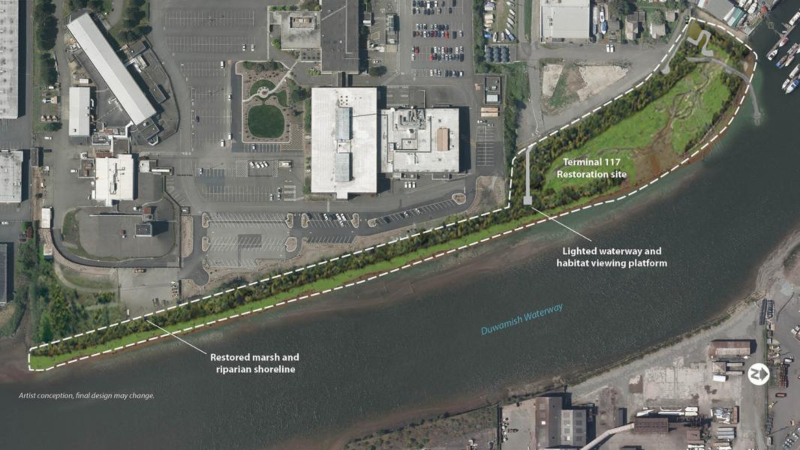
North SeaTac Park
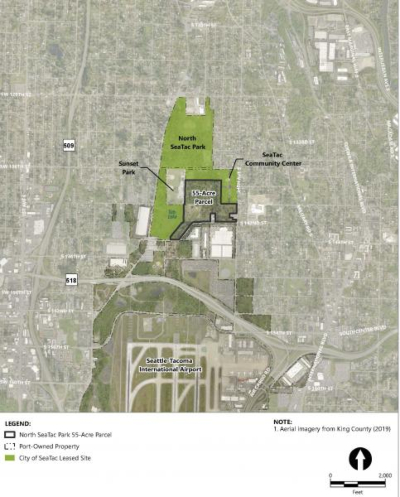 A major effort that I’ll continue to work on next year is finding the best way to protect North SeaTac Park — a 205-acre community and environmental gem. It provides countless opportunities for recreation and serves as a green refuge in SeaTac, which is particularly devoid of trees. The Port leases most of the park to SeaTac for a nominal fee as part of our mitigation for construction of the third runway in the 1990s. Over the years, the city and numerous volunteers have worked hard to protect and embellish the park. Today it’s a treasure enjoyed by visitors from around the region and healthy habitat for much flora and fauna.
A major effort that I’ll continue to work on next year is finding the best way to protect North SeaTac Park — a 205-acre community and environmental gem. It provides countless opportunities for recreation and serves as a green refuge in SeaTac, which is particularly devoid of trees. The Port leases most of the park to SeaTac for a nominal fee as part of our mitigation for construction of the third runway in the 1990s. Over the years, the city and numerous volunteers have worked hard to protect and embellish the park. Today it’s a treasure enjoyed by visitors from around the region and healthy habitat for much flora and fauna.
I sit on the Joint Advisory Committee with Commissioner Mohamed, two City of SeaTac Councilmembers, and the city manager. In addition to overseeing the implementation of our interlocal agreement, we are studying ways to permanently protect the park. The Port currently has no plans to rescind the park’s lease nor to develop any portion of the property. But the City of SeaTac and community members have expressed a desire for the park to be under full control of the City, asserting that local control would more assuredly protect the park permanently.
This past year Port staff and I met with community members, members of Congress, and the Federal Aviation Administration (which provided a grant to the Port to acquire the land on which the park sits) to find a path forward. I’m optimistic a viable solution can be found soon.
This is yet another example of the Port working to address the needs of commerce, climate, and community.
In closing
This has been a very busy year indeed. I’m excited to continue building on these efforts as I start my third term on the Port Commission. I encourage you to stay engaged and encourage your friends to subscribe to my blog by signing up here.
Here’s to working together in 2024!
Sincerely,

Fred Felleman
Port of Seattle Commissioner
Subscribe to receive email updates from Commissioner Felleman


